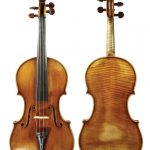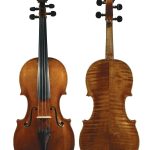A Massive Achievement
Made in 1677, the ‘Romanov’ Nicolò Amati viola is one of the maker’s late masterpieces. Alberto Giordano and Rudolf Hopfner investigate its turbulent history and examine how it fits into the Amati family’s oeuvre
In 2018 an exhibition took place at the Venaria Reale palace near Turin. ‘Precious Instruments, Illustrious Characters’, curated by Giovanni Accornero, featured many treasures including guitars, mandolins and bowed instruments, played by such virtuosos as Pugnani, Paganini and Segovia. In this group of about 30 instruments, among which a few made by the best Cremonese makers of the Golden Age, a viola by Nicolò Amati stood boldly in its glass case: an instrument of large dimensions and its own archaic charm, made in Cremona in 1677 when the luthier was aged 81. Having dominated the string music scene for about a century, by now the large-size tenor viola was slowly going out of fashion. It was replaced by the smaller contralto viola, of which the first designer was probably Girolamo Amati I (1561–1630). The design of the ‘Romanov’ has a particular charm, coming as it does from the family’s lineage: the overall look is reminiscent of the tenor violas made about a century previously by Nicolò’s grandfather Andrea. The overall shape, the carving of the scroll and the design of the f-holes all suggest an archaic approach to the making of this instrument. In 1677 the octogenarian Nicolò was still in control of his workshop, although having delegated the main benchwork to his son, Girolamo II (1649–1740). He had spent all his life in Cremona, living through periods of great difficulty and financial success. He had married late and Girolamo, a talented maker himself, was in place to inherit the family business. After Nicolò’s death in 1684, however, Girolamo’s life went rapidly to ruin: oppressed by debts, in 1697 he left Cremona. It is intriguing to speculate on Girolamo’s contribution to the workshop, considering that his approach to violin making appears more spontaneous and instinctive, perhaps less refined and sometimes even crude. Girolamo was probably more concerned with acoustic matters rather than in the finishing of his instruments. His archings are generally bolder than his father’s and according to John Dilworth he may have been trying to rival the sound of Jacob Stainer, highly fashionable among players of the time. For several years the ‘Romanov’ Amati was the principal performing instrument of Max Aronoff (1906–81), violist of the celebrated Curtis Quartet. It had been acquired in 1935 by Mary Louise Curtis Bok, patroness and founder of the Curtis Institute of Music, along with the quartet’s other instruments, two Stradivari violins and a Montagnana cello. The viola was described in dramatic fashion in the pages of the Lewiston Evening Journal on 13 April 1939: ‘an Amati viola that is one of only two of its kind in the world’ that had been twice removed from ‘countries seething with violence and bloodshed’. Recent research by Philip Kass and Giovanni Accornero has given clarity to this intriguing story. For two centuries the viola had been the property of the aristocratic Leoni family of Venice. It was probably a Leoni who had commissioned it from Nicolò in the first place. It came to Pietro Carlo Leoni (d.1874), a man of culture, a patriot and an opponent to the Austrian occupation in his home town: the mid-19th century was a troubled time for Venice, suffering not only under the yoke of Austrian occupation but also from a cholera epidemic. Pietro Carlo, in trouble with the Habsburg police and fearing his properties could be confiscated, entrusted the viola to his friend, the cellist Francesco Ciandi, who brought it to St Petersburg where he was performing in an opera orchestra. Upon Leoni’s death, Ciandi sold the viola to the Princes Romanov, whence it became part of the Royal Collection. From Italy to Russia and then to the US: just after the Russian Revolution, Prince Vasili Alexandrovich Romanov (left), the nephew of Tsar Nicolas II, brought the viola to New York City and sold it at the end of the 1920s to the dealer Emil Hermann. He in turn sold it to Curtis Bok and it remained in the hands of the Institute until 1944. It is housed today in a private collection. The front of the ‘Romanov’ is made from two pieces of good-quality spruce. The grain is very narrow near the joint and wider around the borders. The back is made from the Italian maple called oppio. The wood is fairly plain, with a few knots: it is possible Nicolò chose lower-quality wood because this specific viola was probably to be sold for a low price. It is interesting to note that the back is 6mm thick at the centre. This could be the original graduation, as the back was modified little during the resizing. Following the tradition of tenor viola making, the archings of the ‘Romanov’ viola are quite low and slightly flat. As it originally had a body length of around 47cm, it was designed so that it would require no extra effort from the player to use it. Moreover, tenor violas were usually played in first position only and, in order to facilitate the bow action, the heights of the archings were kept quite low. In spite of the resizing, we can still enjoy the view of the curves sculpted by the Amatis: the lines flow in quite a flattened way and, unlike the usual archings carved by Nicolò, there is no channelling over the purfling area – they go straight to the edges remaining quite full all along the contour. On the back, the carving work undertaken by Girolamo is clearly visible: in the area of the upper corner-blocks, one can see some flat lines showing a faulty connection to the arching, and generally the look in the chest area is a little bumpy. It must be noticed that, apart from in the scroll, there are no visible toolmarks or signs of work, in accordance with Nicolò’s belief that an Amati instrument should appear immaculate. The edgework and purfling are particularly striking. The purfling, probably of poplar, appears strong, elegant and impressive in its general proportions: the ‘black’ is actually stained a startling deep blue–black colour. It would be every contemporary maker’s dream to have the recipe for that staining process! The thickness of the purfling is consistent at about 1.4–1.5mm throughout; it is inserted at 4.3–4.4mm from the edges, allowing the bee-stings to elongate gently, creating a perfect balance at the borders. These bee-stings extend to the very edge of the corner, slightly deflecting from parallel at the ends. The scoop is mellow and smooth, only 0.7–0.8mm deep, and barely reaching 1mm in the corners and at the C-bouts. The scoop has been gently rounded, as are the inner edges towards the sides, and the flat plane joining the sides has been consistently reduced; this section of the border is quite oval all along the contour. The thickness is generous, being 4.3mm in the upper and lower bouts and increasing up to 5.2–5.7mm in the corners and C-bouts. The direct influence of Nicolò’s grandfather Andrea can be identified in the drawing of the f-holes of the ‘Romanov’: although partially redesigned and modernised from Andrea’s model, the outline of the f-holes recalls the earlier model in the wide upper and lower eyes and in the short wings that give a kind of archaic look to the front. Apart from a mistake of about 1mm in the alignment of the upper eyes, the f-holes appear to be symmetrical and correctly placed according to the centre line. A few discrepancies are to be noted on the outline of the body; the treble-side f-hole is slanted a little inward while that of the bass side looks more well-balanced with the outline. The carving is fast and secure, done with a knife; there are a few indentations in a few places along the contour. The eyes were also cut with a knife, and the flanks are undercut on the inner side facing the bridge. They are almost perpendicular to the arching in the sides facing the purfling. The lower wings were left plain without any scoop, and were connected to the arching after the edgework with a scraping work that left the hard grain clearly marked. The operation wasn’t wholly successful, as a few bumps and irregularities are still visible in the lower side. The wide nicks, opened with the knife, were gently rounded, smoothed and elongated towards the centre with a slightly marked line that gives a balanced beauty to the view of the f-holes. The design of the scroll shows no signs of innovation. It was directly taken from the repertoire of the Amati family, since the outline and the volute are almost coincident with the model of Andrea’s tenor violas. The wood of the scroll was chosen without any particular care, being a simple piece of plain, half-slab-cut maple; although the carving appears at first sight to be a bit fast and careless, it fully reveals the skill and experience of Girolamo. The entire work is spontaneous, free and full of motion and although revealing a certain disregard in the perfection of the finishing, it gives a cool sensation to the viewer. On the side view one can see the uneven surface of the pegbox that, finished with a scraper, shows light irregularities, pleasantly sensitive to the touch.
The almost flat surface of the pegbox is scooped just after the throat where the first turn begins. Here, it is possible to see the marks of the radial cut undertaken by Girolamo, going deeper as the turns flow to the button: the finishing action of the scraper couldn’t entirely remove those marks that are still visible and detectable by touch. The front view presents a beautiful and well-balanced drawn fan, with the turns perfectly aligned and cut with quite a small gouge that had left tiny and regularly distanced marks of the cut. The classical Amati-style chamfer appears well rounded and even bold in the front view, while from the side view it is lighter and thinner; there is no centre line on the scroll, and only the pinpricks of the compass that traced the outline are visible. Unlike the habit of Nicolò, who used to carve the two channels up to the throat, the scoop in the front terminates before the last quarter of the turn, flowing in a single scooped channel. The end of the centre line, sharply worked with a knife, gently disappears. The pegbox cheeks are straight and bold, barely chamfered in the inside, more wildly cut on the outside with a knife that left a few indentations, and smoothed with a scraper before the instrument was varnished. The rear view features two pinpricks in the lower side, one for the alignment of the flanks of the pegbox, the other for the button. The scoop is well cut and it shows a few marks of transverse work, ending in a beautiful button, so balanced and delicate, in which the rounding of the chamfer and the scoop are perfectly connected The internal construction of the soundbox has been carefully investigated by Rudolf Hopfner. The micro-CT scans (above) with a resolution of 0.14mm, give an impression of the overall condition of
the instrument and of the alterations the instrument has been subjected to. The corner-blocks seem to be original, but they have probably been reduced in size. The most obvious modification is in the reduction of the body length. Both plates have half-moon-shaped doublings, covering the area from the maximum width of the respective bout to the end of the plate. In this area, only a small portion of the belly’s edge is original, whereas other portions are replacements. Amati’s instruments, as well as those of his students, often have a dorsal pin in the centre of the back plate. On this viola no such mark is visible.
The surviving varnish, still admirable especially on the back of the instrument, reveals all its original beauty. The ground, with a shiny honey-chestnut hue, appears magnificently reflective and deep,
succeeding in enhancing the light flame of this rather plain wood.The amber-like colour of the varnish was probably obtained by the cooking process only. Looking at the maple under a magnifying glass, it seems that the maker deliberately caused the varnish to penetrate the ground layer slightly. This would have been to get a deeper colour. Its fine texture is gently melted with the rich ground, giving the viewer the sensation of a pure, natural golden-brown glow. Today the overall look of the ‘Romanov’ is extremely pleasant, like the best of Nicolò Amati’s instruments.
The authors wish to thank Carlo Chiesa, John Dilworth, Philip Kass and Andrea Zanrè for their help with this article
Subscribers to The Strad receive a free copy of the ‘Romanov’ Amati poster, including measurements and micro-CT scans. Alberto Giordano explains the rationale behind the choice of instrument
This is only the third poster of a Nicolò Amati instrument in The Strad’s history – perhaps surprising given the maker’s significance to the world of violin making. Nicolò’s violins have been overshadowed by the great works of Stradivari, Guarneri ‘del Gesù’ and Guadagnini which are generally better for large concert halls: as a consequence, contemporary makers seldom choose Nicolò Amati models for their violins (unless making a Baroque instrument specifically). When it comes to violas, however, there is a different trend: when I was a judge at the 2018 Cremona Triennale it was a nice surprise for me to see how many violas were based on Amati models. When using a Stradivari violin pattern it’s important to respect the original design. It is not advisable to make significant changes to the proportions to a mould that is apparently perfect: you cannot mess up with a Strad model. For viola making, a Nicolò Amati model can be modified much more successfully without losing its original spirit and balance: the relationship between the f-holes and the central body, for instance, can be more easily modified when resizing the instrument. For this reason, it makes sense to publish a poster of a resized large viola; and given that digital technologies are now available to everyone, makers will be able to adjust the model according to their own needs and personal solutions. The good side of viola making is that there is still a great deal to be learnt in terms of sound research, and that it gives makers a chance to develop their own style while respecting the classical roots of our tradition.
To order a rolled copy of the poster, simply visit The Strad Shop at www.thestradshop.com
Copyright © 2019 Alberto Giordano, The Strad magazine All rights reserved






